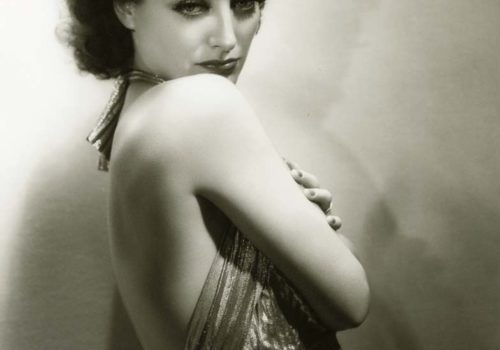George Hurrell started work at MGM at the beginning of 1930 and almost immediately transformed Hollywood photography. Brought to MGM at the insistence of Norma Shearer, his task was to make his subjects, especially women, sexy. Not only did he succeed but his work, in this respect, has never been bettered.
Norma Shearer was an attractive and talented actress, who through determination and fortitude, not to mention marriage to MGM’s top producer Irving Thalberg, managed to secure most of the studio’s choicest female roles. But she found herself increasingly cast as the nice girl or sophisticated matron when she wanted the racier roles given to Joan Crawford and Greta Garbo. Hurrell changed Shearer’s appearance, at least in the portrait gallery, and there is no question that the lovely lady portrayed by Ruth Harriet Louise took on a new and smoldering guise when seen through Hurrell’s lens.
Hurrell’s very best work was saved for Joan Crawford who likely enjoyed being photographed more than any actress before Marilyn Monroe. Of the approximately 100,000 photographs that were coded by MGM’s publicity department from 1924 through 1942, Crawford’s face appears more often than any other star. Hurrell and Crawford enjoyed an extraordinary collaboration beginning at MGM and continuing after he went independent in late 1932. Hurrell could be almost brutal with his sitters subjecting them variously to strong lights, extreme close-ups, and complicated positions. Crawford survived all of Hurrell’s antics and her allure was only heightened by his inventive camerawork.
Glamour was Hurrell’s hallmark and he saved the best for his ladies. Harlow reached her peak of sexual allure in front of Hurrell’s lens as did Carole Lombard and Veronica Lake when he shot portraits for Paramount. As good as Hurrell was in the 1930s, his 1943 photographs of Jane Russell in the hay, taken to promote The Outlaw, are likely his most famous and frequently reproduced. Hurrell did not have the temperament to last long as part of a studio team. He remained available to MGM on a contract basis throughout the 1930s, photographing Harlow, Gable and Crawford, among others, both at his studio and at MGM. From 1938 to 1940 he was employed by Warner Brothers. Otherwise he worked independently, available to anyone who would pay his stiff fee.
So extraordinary were Hurrell’s photographs that he may be said to have revolutionized the depiction of Hollywood actors. Using an easily movable boom light that he modeled on a boom microphone, he illuminated cheekbones and created shadows under his subjects eyes and nose. “The most essential thing about my style was working with shadows to design the face instead of flooding it with light” he said. His inventive use of strong contrasts of black and white gave his subjects an almost sculptural quality and added a masculinity to his male subjects that was consistent with the new tough guy image associated with stars like Gable and Cagney. His radical re-touching of his negatives’ surfaces made women glow like never before. Before Hurrell, Norma Shearer was an attractive actress; in front of his lens she became a screen siren. Looking back on the photographers from the studio system’s first two decades, Hurrell stands out as the best, and his transformative images have come to define an era.
















